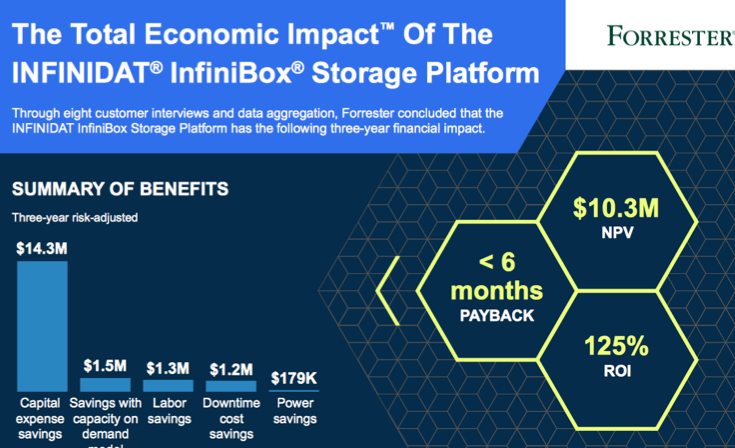From Infinidat, Impact of IoT and Edge Devices on Storage
Firm's software-defined data center architecture set of validated architectures and designs, delivering consistent, certified security infrastructure
This is a Press Release edited by StorageNewsletter.com on May 21, 2021 at 2:31 pm By Erik Kaulberg, VP, tech alliances, Infinidat Ltd.
By Erik Kaulberg, VP, tech alliances, Infinidat Ltd.
IIoT and edge devices are creating massive flows of data that obviously need to be stored somewhere.
These devices include everything from a smartphone in a person’s pocket to a sensor on machinery to security devices to a NAS in a remote location far from a data center. Just as there are benefits to IoT and smart edge devices, there are substantial implications on storage.
According to IDC, there will be over 40 billion connected IoT devices by 2025, used for a range of purposes, including security and surveillance, tracking, supply chain automation, inventory management, and facilities management. Furthermore, 5G Technology World reported that 5G networks will increase the number of connected devices per unit by 100x.
According to a Microsoft IoT Signal Research Report, over 90% of enterprises are projected to be using IoT devices by the end of 2021. Data from these devices can help facilitate predictive maintenance, demand forecasting and usage tracking. Edge systems can reduce errors and streamline manufacturing processes as well as optimize inventories. They help minimize the challenges with supply chains and the customer lifecycle. This is all part of the digital transformation that IoT is helping to enable.
The proliferation of IoT and edge devices has created an increasing number of environments with intensely dense data workloads. It has also delivered a reality check. IT departments are often unaware of exactly how many IoT devices are on the network or how much data traffic will be coming from them in any given timeframe. Potential unexpected spikes in data can wreak havoc with an enterprise’s storage costs and ability to be flexible.
The big challenge is that traditional storage cannot keep up with the scale requirements of those types of environments and cannot keep costs down. The question that CIOs and other IT leaders at enterprise-sized organizations need to answer for themselves is: what are you going to do to manage that massive scale of data while maintaining minimal complexity and minimal cost?
Striking right balance
Data is coming in from all of these edge and IoT devices outside the traditional data center. Even just processing the exponential increase of security information from end-point devices is a challenge. IT teams are tasked with centralizing all this data into a data repository, which needs to support the right balance of economics and functionality for any well-managed enterprise IT infrastructure.
Scalability, cost, performance and resiliency are important to any storage discussion, and this is especially true with edge and the IoT where you have these massive data volumes. It’s not just the performance to keep up. It’s all of these 4 factors mixed together. It’s effectively the ability to provide the storage infrastructure while not over-paying for it.
Indeed, economics are particularly important. Most of the next-gen storage solutions available today focus on expensive flash media, but it is possible to reduce costs by an order of magnitude with a mix of flash and disk storage – a combination that large cloud hyperscalers are actively leveraging for favorable storage economics today. Infinidat is a storage provider that is blending flash and disk at petabyte scale for general enterprise workloads, lowering the TCO.
Best practice
As IoT deployments become more complex and more companies are looking to edge device-enabled analytics, enterprise IT teams are looking for new ways to enable scalability, yet keep administrative complexities and costs down. They are increasingly turning to a comprehensive software-defined data center (SDDC) strategy that delivers security for IoT and edge devices. It needs to be able to improve security, automate compliance and speed up the time for data recovery from cyberattacks, such as ransomware.
Infinidat’s SDDC architecture for IoT and edge security is a set of validated architectures and designs, delivering a consistent, certified security infrastructure. It involves security information and event management (SIEM) for real-time security monitoring, threat detection, forensics and incident management.

Storage is at the heart of any large-scale IoT security environment, because the more context you can preserve for events, the more likely you can identify sources and recover quickly. This SDDC strategy leverages a SDS platform delivered in a hardened hardware appliance. In this software-defined model, it is important to have a high-performance, HA storage platform at scale with lower cost than alternative solutions. Otherwise, enterprises will pay 2x or 3x more than they actually need to pay for storage.
Overall, the advantages of SDDC include adaptable automation and lifecycle management, service-level orchestration, and a time to value measured in weeks, rather than months. SDDC reduces complexity, maximizes efficiency, and reduces TCO. And it provides integration with data center management tools for a more cohesive user experience.
Fast cyber recovery time
Cyberattacks on IoT devices have increased by 300%, according to security researchers at F-Secure in a report that was published last year. For example, ransomware attacks are increasingly being used to shut down IoT devices, include those used in critical infrastructure.
Security breaches result in downtime, data and IP theft, and damage to corporate reputation, among other things.
Conventional storage systems are inadequate to support IoT Edge networks, much like conventional security systems themselves. IoT Edge networks produce significant volumes of data generated on IoT networks on a daily basis that can quickly overwhelm conventional systems. Core IT departments may not even be able to catalogue all the IoT devices connected to their systems.
Increasingly sophisticated attack vectors and aging architectures, as well as poor line-of-sight visibility by information security teams, are among the reasons for the rapidly increasing security issues. What has happened is that edge and IoT device networks have expanded the security attack surface. The inadequacies of many systems are being exposed.
What is needed is a system to acquire, store and analyze the vast amounts of data needed to monitor and protect IoT and edge devices and networks. CIOs and other IT leaders are smart to look to simplify storage, seeking to make it fast, reliable and flexible – and able to grow as easily as possible.
IoT and edge devices require both newer cybersecurity technologies as well as scalable storage systems that can keep up with them in the rapidly evolving technology climate. Part of the solution is for enterprises to reduce the recovery time of breaches, utilizing the latest cyber recovery capabilities.
It is wise to have a cyber recovery solution in place that does near-instantaneous recovery of data. One of the new strategies that IT teams can adopt for cyber recovery is the use of immutable snapshots, which cannot be changed. The combination of storage and data protection gives enterprises a stronger set of capabilities to manage IoT and edge devices.
Data-centric enterprises
Companies need large amounts of data more than ever to garner the insights that they need to manage their businesses, improve agility and respond swiftly to changing customer needs. They analyze the data, seeking to identify trends that will help them gain competitive advantages in the market or pre-emptively isolate issues that can be neutralized before causing significant damage. This means that they need to store the data for long periods of time.
It would be a miss to only store data for a month when a hard-to-detect, yet business-critical indicator only happens, for example, every six weeks. Companies need to keep information long enough to turn raw data from different sources into meaningful insights and predictions. You’re never going to get that picture unless you are retaining data for at least a year. Making it cost effective without administrative overhead is vital.
Edge and IoT scenarios are also unlocking new applications, which is an area of rapid change, in general, in enterprise IT. The trajectory in the enterprise market is leaning to more data, not less data. This changes the way companies need to approach storage and data protection, balancing a scalable storage platform and a cyber recovery system with near-instantaneous data restore capabilities.













 Subscribe to our free daily newsletter
Subscribe to our free daily newsletter

